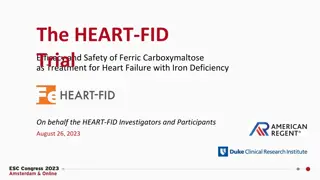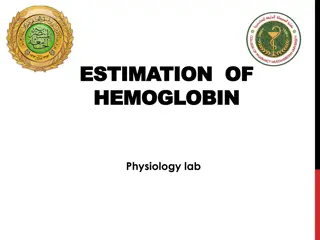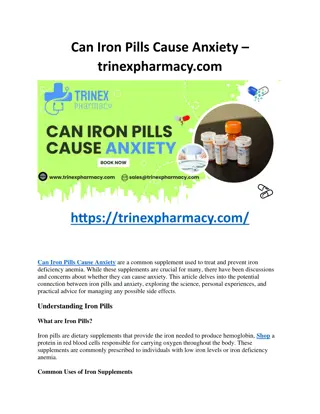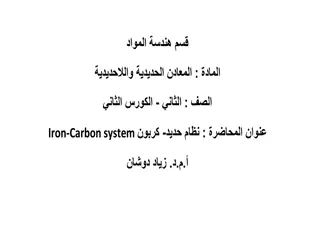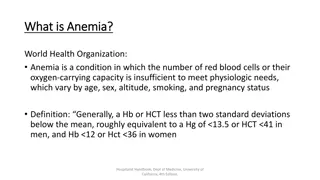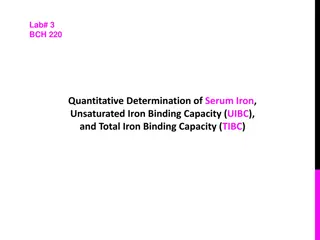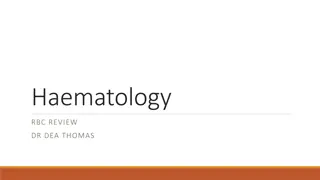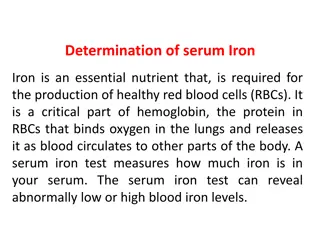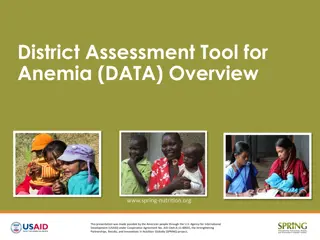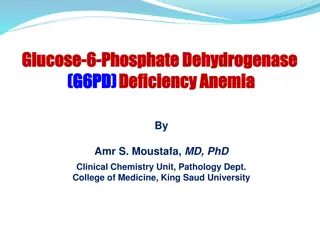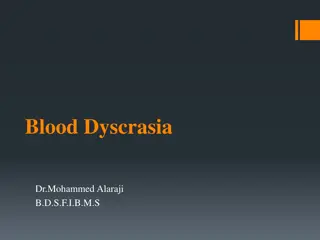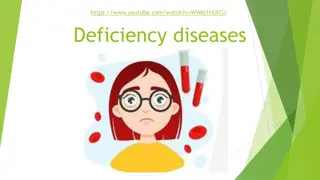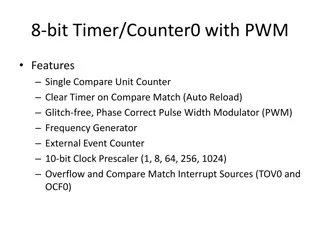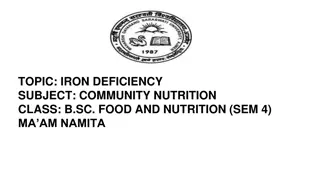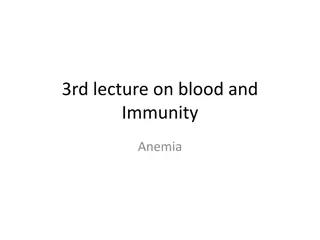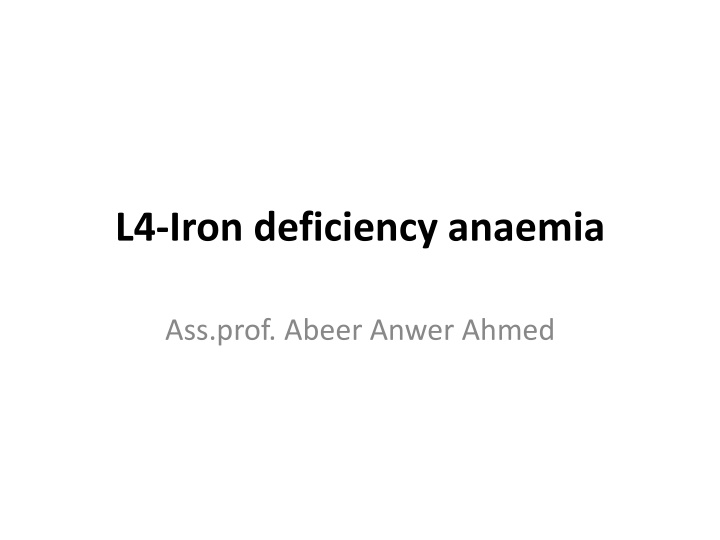
Iron Deficiency Anemia
Iron deficiency anemia is a condition that develops due to depletion of iron stores in the body, leading to various stages of iron-deficient erythropoiesis and eventually causing microcytic and hypochromic red cells. This deficiency can result in severe tissue effects such as koilonychia, hair thinning, and glossitis. Early detection and appropriate treatment are crucial in managing this common blood disorder.
Download Presentation

Please find below an Image/Link to download the presentation.
The content on the website is provided AS IS for your information and personal use only. It may not be sold, licensed, or shared on other websites without obtaining consent from the author. If you encounter any issues during the download, it is possible that the publisher has removed the file from their server.
You are allowed to download the files provided on this website for personal or commercial use, subject to the condition that they are used lawfully. All files are the property of their respective owners.
The content on the website is provided AS IS for your information and personal use only. It may not be sold, licensed, or shared on other websites without obtaining consent from the author.
E N D
Presentation Transcript
L4-Iron deficiency anaemia Ass.prof. Abeer Anwer Ahmed
Sequence of events Depletion of iron stores When the body is in a state of negative iron balance, the first event is depletion of body stores, which are mobilized for haemoglobin production. Iron absorption is increased when stores are reduced, before anaemia develops and even when the serum iron level is still normal, although the serum ferritin will have already fallen.
Iron - deficient erythropoiesis With further iron depletion,manifested by : a serum ferritin below 15 g/L and fall in serum transferrin aturation to less than 15%, iron - deficient erythropoiesis develops with increasing concentrations of serum transferrin receptor and red cell protoporphyrin. At this stage, the haemoglobin, mean corpuscular volume (MCV) and MCH may still be within the reference srange, although they may rise significantly when iron therapy is given.
Iron deficiency anaemia If the negative balance continues, frank iron deficiency anaemia develops. The red cells become obviously microcytic and hypochromic and poikilocytosis becomes more marked. The MCV and MCH are reduced, and target cells may be present. The reticulocyte count is low for the degree of anaemia. The serum TIBC rises and the serum iron falls, so that the percentage saturation of TIBC is usually less than 10%.
B.M The number of erythroblasts containing cytoplasmic iron (sideroblasts) is reduced at an early stage in the development of deficiency, and siderotic granules are entirely absent from these cells when iron deficiency anaemia is established. The erythroblasts have a ragged vacuolated cytoplasm and relatively pyknotic nuclei. The bone marrow macrophages show a total absence of iron, except where very rapid blood loss outstrips the ability to mobilize the storage iron. Platelets are frequently increased
Tissue effects of iron deficiency When iron deficiency is severe and chronic, widespread tissue changes may be present, including: koilonychia (ridged nails, breaking easily), hair thinning, angular stomatitis (especially in those with badly fitting dentures), glossitis and pharyngeal webs (Paterson Kelly syndrome). Partial villous atrophy, with minor degrees of malabsorption of xylose and fat, reversible by iron therapy, has been described in infants suffering from iron deficiency, but not in adults. Pica is sometimes present; in some who eat clay or chalk, this may be the cause rather than the result of iron deficiency.
Iron - dependent enzymes in the tissues are usually better preserved than other iron - containing compounds. In severe iron deficiency, however, these enzymes are not inviolate and their levels may fall. This may be partly responsible for the general tissue changes, with mitochondrial swelling in many different cells (including, in the experimental animal, hepatic and myocardial cells), poor lymphocyte transformation and diminished cell - mediated immunity, and impaired intracellular killing of bacteria by neutrophils.
A particular concern has been the finding that infants with iron deficiency anaemia may have impaired mental development and function, and that this deficit may not be completely restored by iron therapy. There is recent evidence that premature labour is more frequent in mothers with iron deficiency anaemia. It remains controversial whether impaired work performance seen in adults results from the anaemia or from depletion of mitochondrial iron - containing enzymes. It is also unclear to what extent some of the other tissue effects of iron deficiency can occur even in the absence of anaemia.
Causes of iron deficiency Blood loss Uterine: menorrhagia, post- menopausal bleeding, parturition ,Gastrointestinal: oesophageal varices, hiatus hernia, Helicobacter pylori , peptic ulcer, aspirin ingestion, hookworm, hereditary telangiectasia, carcinoma of the stomach, caecum or colon, ulcerative colitis, angiodysplasia, Meckel diverticulum, diverticulosis, haemorrhoids, etc. Renal tract: haematuria (e.g. renal or bladder lesion), haemoglobinuria (e.g. paroxysmal nocturnal haemoglobinuria) Pulmonary tract: overt haemoptysis, idiopathic pulmonary haemosiderosis Widespread bleeding disorders Self - inflicted Malabsorption Gluten - induced enteropathy (child or adult), gastrectomy, atrophic gastritis, chronic inflammation, clay eating, etc. Dietary Especially vegetarian diet
Diet Defective intake of iron is rarely the sole or major cause of iron deficiency in adults in Western communities. The diet may contain insufficient or poorly available iron as a result of poverty, religious tenets or food faddism. Iron deficiency is more likely to develop in subjects taking a largely vegetarian diet the majority of the world s population who also have increased physiological demands for iron
Increased physiological iron requirements Iron deficiency is common in infancy, when demands for growth may be greater than dietary supplies. It is aggravated by prematurity, infections and delay in mixed feeding. It is also frequent in adolescence, in females and in pregnancy The fetus acquires about 280 mg of iron and a further 400 500 mg is required for the temporary expansion of maternal red cell mass. Another 200 mg of iron is lost with the placenta and with bleeding at delivery. Although iron absorption increases throughout pregnancy and increased requirements are partly offset by amenorrhoea, this may not be sufficient to meet the resultant net maternal outlay of over600 mg iron.
Blood loss Blood loss is the most common cause of iron deficiency in adults. A loss of more than about 6 8 mL of blood (3 4 mg iron) daily becomes of importance, as this equals the maximum amount of iron that can be absorbed from a normal diet.
loss is usually from the genital tract in women or from the gastrointestinal tract in either sex. The most common cause on a worldwide basis is infestation with hookworm, in which anaemia is related to the degree of infestation. In the UK, menorrhagia, haemorrhoids and peptic ulceration are common, as well as gastric bleeding because of salicylates or other non - steroidal anti- infl ammatory drugs, hiatus hernia, colonic diverticulosis and bowel tumours . Some unusual causes of blood loss deserve mention. Cow s milk intolerance in infants may lead to gastrointestinal haemorrhage. Self - induced haemorrhage may occur. Chronic intravascular haemolysis, such as that in paroxysmal nocturnal haemoglobinuria or mechanical haemolytic anaemia, may be a serious source of urinary iron loss.
Malabsorption Malabsorption may be the primary cause of iron deficiency or it may prevent the body adjusting to iron deficiency from other causes. Dietary iron is poorly absorbed in gluten - induced enteropathy, in both children and adults. Gluten - induced enteropathy is encountered in about 5% of patients presenting with unexplained iron deficiency anaemia and, conversely, about 50% of patients with newly diagnosed coeliac disease have coexistent iron deficiency anaemia. Patients with this disease often show decreased or no response to oral therapy with inorganic iron.
Helicobacter pylori gastritis appears to be a common cause of iron deficiency, responding favourably to eradication with triple therapy. Helicobacter pylori gastritis inhibits gastric hydrochloric acid secretion, interfering with the solubilization and absorption of inorganic food iron but it is also possible that gastrointestinal blood loss plays a signifi cant role in the causation of iron defi ciency associated with H. pylori infection
achlorhydria associated with autoimmune gastritis, an entity preceding and closely related to pernicious anaemia, is an important cause of iron malabsorption due to impaired food iron solubilization. It is encountered in about 20% of patients with unexplained or refractory iron deficiency anaemia, mostly women of fertile age in whom achlorhydria aggravates the consequences of menstrual blood loss.
Management of iron deficiency (i) identification and treatment of the underlying cause and (ii) correction of the defi ciency by therapy with inorganic iron. Iron defi ciency is commonly due to blood loss and, wherever possible, the site of this must be identifi ed and the lesion treated.
Oral therapy In most patients, body stores of iron can be restored by oral iron therapy. ferrous sulphate is the cheapest, this is the drug of first choice 200 mg of ferrous sulphate contains 67 mg of iron. Where smaller doses are required, 300 mg of ferrous gluconate provides 36 mg of iron. It is usual to give 100 200 mg of elemental iron each day to adults and about 3 mg/kg per day as a liquid iron preparation to infants and children. The side - effects of oral iron, such as nausea, epigastric pain, diarrhoea and constipation, are related to the amount of available iron they contain.
The minimum rate of response should be a 20 g/L rise in haemoglobin every 3 weeks, and the usual rate is 1.5 2.0 g/L daily. This will be slower when the dose tolerated is less than 100 mg/day, but this is seldom of clinical importance. It is usually necessary to give iron for 3 6 months to correct the deficit of iron in circulating haemoglobin and in stores (shown by a rise in serum ferritin to normal)
Positive response in reticulocytosis is seen in few days of oral therapy Hb should reach to normal level after 2 months A Hb response of <20 g/L over a 3-week period warrants therapy evaluation Day-14 Hb may be a useful tool for clinicians in determining whether and when to transition patients from oral to IV iron. an increase of 1.0 g/dL or more over baseline is an accurate predictor of longer-term and sustained response to continued oral therapy
Iron profile should be measure in the first week for oral therapy and 2 weeks after large intravenous doses Complete therapeutic response requires iron supplementation for up to 2-6 months, however, symptoms may improve within few days after oral therapy
Failure to respond to oral iron most commonly due to : -patient not taking it -continued haemorrhage or malabsorption. -other causes of microcytic anaemia such as iron - loading anaemias. For instance, many patients with, bone marrow examination or other tests have revealed the co thalassaemia trait, sideroblastic anaemia or other anaemias have been treated with iron before haemoglobin studies ,bone marrow examination or other tests have revealed the correct diagnosis. -patient has an infection, renal or hepatic failure, an underlying malignant disease or anaemia of inflammation due to high hepcidin levels (which inhibits absorption of therapeutic oral iron) and any other cause of anaemia in addition to iron deficiency
Parenteral i ron t herapy This is usually unnecessary, but it may be given if subjects -cannot tolerate oral iron, particularly if gastrointestinal disease, such as inflammatory bowel disease, is present. It is also occasionally necessary in gluten - induced enteropathy -it is essential to replete body stores rapidly (e.g. where severe iron deficiency anaemia is first diagnosed in late pregnancy) - when oral iron cannot keep pace with continuing haemorrhage (e.g. in patients with hereditary haemorrhagic telangiectasia). -Patients with chronic renal failure who are being treated with recombinant erythropoietin are also likely to require parenteral iron therapy.
From all parenteral preparations, the iron complex is taken up by macrophages of the reticuloendothelial system, from which iron is released to circulating transferrin, which then transports it to the marrow
three preparations are available . Iron dextran (CosmoFer) is given intravenously by slow injection or infusion or deep intramuscularly into the gluteal muscle. An iron sucrose complex, Venofer, is given by slow intravenous infusion or injection. The deficit in body iron should be calculated from the degree of anaemia; it is usually1 2 g. In patients receiving erythropoietin treatment in chronic renal failure, smaller intravenous doses of Venofer (25 150 mg/ week) may be used, with regular monitoring of serum ferritin to avoid iron overload. Ferrinject is a macromolecular iron(III) -hydroxide carbohydrate complex (molecular weight approximately 150 000). It can be administered as an intravenous bolus (maximum single dose 200 mg) or slow infusion (maximum single dose 1000 mg). Newer intravenous preparations including ferumoxytol and ferrous gluconate (Ferrlecit) may become available.
Iron refractory iron deficiency anaemia Homozygous or doubly heterozygous germline frameshift, splice junction or missense mutations of matriptase - 2( TMPRSS6 ) are a cause of iron refractory iron deficiency anaemia.. The patients show a microcytic hypochromic anaemia with normal or raised serum and urine hepcidin levels and Low serum iron and percentage saturation of iron binding capacity The patients absorb iron poorly and are refractory to oral iron therapy but are partially responsive to parenteral iron.
the TMPRSS6 gene encoding Matriptase-2 Matriptase-2 (MT-2).. is a transmembrane serine protease that cleaves Hemojuvelin, a major regulator of hepcidin expression and plays an essential role in down-regulating hepcidin, the key regulator of iron homeostasis.
mutations of DMT1. A microcytic hypochromic anaemia with liver iron overload has also been described in a few patients with homozygous or doubly heterozygous mutations of DMT1 Liver iron stores are increased but erythroid iron utilization is impaired and Serum hepcidin levels are low for the degree of iron overload. These patients may respond to erythropoietin injections. The patients are susceptible to infections.
Deficiency of serum transferrin due to mutations of the transferrin gene causes a hypochromic microcytic anaemia with tissue iron overload caused by increased plasma non - transferrin - bound iron and low hepcidin levels. Treatment hasbeen with infusions of fresh frozen plasma or apotransferrin. Deficiency of caeruloplasmin also causes a mild hypochromic microcytic anaemia with iron overload in the liver and progressive neurodegeneration. There is failure of ferroxidase activity, which impairs iron mobilization from stores.

